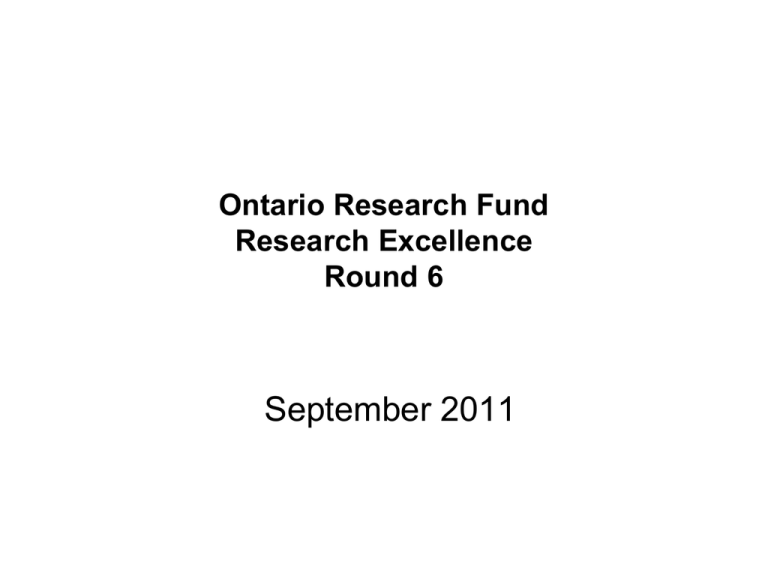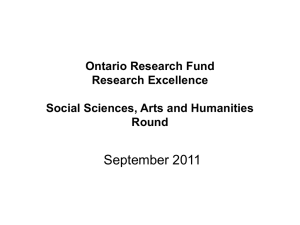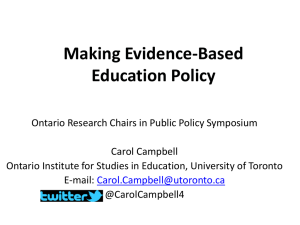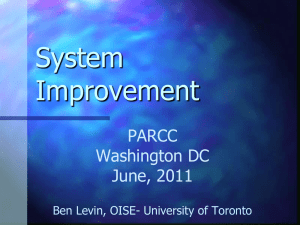ORF-RE Round 6 - Research and Innovation
advertisement

Ontario Research Fund Research Excellence Round 6 September 2011 Introduction • The Ontario Research Fund Research Excellence (ORF-RE) program promotes research excellence in Ontario by supporting transformative, internationally significant research • The ORF-RE focuses on scientific excellence and strong commercialization, and targets new leadingedge research initiatives 2 Comprehensive Research Investments Create Capacity and a Strong Knowledge Base MRI DIRECT DELIVERY builds capacity by providing comprehensive research support in all research disciplines PEOPLE: Research talent programs, a central part of the knowledge creation ecosystem, support attraction/retention of researchers throughout their career development INFRASTRUCTURE: Ontario Research Fund –Research Infrastructure (ORF-RI) supports modernization, development and acquisition of new infrastructure (small/individual to large/institutional) and is administered in concert with Canada Foundation for Innovation (CFI) OPERATIONS: Ontario Research Fund –Research Excellence (ORF-RE) supports transformative, internationally significant research projects · Post-Doctoral Fellowship Program (PDF) ·Early Researcher Awards (ERA) ORF-RI: Small Infrastructure Grants to Attract and Retain Researchers ·ORF-RI: Large-Scale Infrastructure Grants for Transformative Research ·ORF-RE Builds research teams (graduate students, PDFs) led by established scientists (principal investigators and co-investigators) INSTITUTE MODEL, funded by MRI to advance translational and focused research in specific research areas The Ontario Institute for Cancer Research (OICR) is an internationally renowned hub for multi-disciplinary, multiinstitutional collaborations in translational cancer research The Ontario Brain Institute (OBI) facilitates multi-disciplinary, multi-institutional research collaborations in neuroscience OICR, OBI, PI Continue to raise Ontario’s global reputation in research community ONTARIO RESEARCH FUND (ORF) is Ontario’s Flagship, Best-in-Class, Research Program • Supports scientific excellence that can be developed into innovative goods and services that will boost Ontario's economy • Provides talented researchers with the support they need to undertake cutting-edge research • Designed to provide Ontario’s research community with one window access for research funding • A key component of the province’s Innovation Agenda, the ORF keeps Ontario researchers at the leading-edge by supporting: ORF Share of Funding by Focus Areas Other Disciplines $204,5M Digital media and ICT $152M Advanced Health Technologies $575M Bio-economy and clean technologies – the operational costs (direct and indirect) of research through RESEARCH EXCELLENCE program – the capital costs of research through its RESEARCH INFRASTRUCTURE program $215.2M Since 2004, $1.17B committed towards 1,500 research projects in OIA focus areas, leveraging $2.5B leveraged from partner funding from institutions, federal government and the private sector. ORF-RESEARCH EXCELLENCE Supports Large Scale Research Operations With Commercialization Potential • Represents a unique opportunity for Ontario researchers to conduct large scale, transformational research with commercial potential Provides research institutions $1M$4M for operating and indirect costs • Combines public research push with a market pull by requiring partnerships with industry. ORF-RE funding formula requires partnership of: ORF-RE one-third total project cost Industry one-third of total project cost Institutions one-third total project cost • To date, $556.6 million committed for 140 research projects through 5 ORF-RE rounds, leveraging $1.1B in private sector and institutional contributions. Results include 5,450 highly qualified people and 625 industrial and institutional partnerships Other Disciplines $67,3M Digital Media and ICT $86,1M Advanced Health Technologies $265,4M Bio-economy and Clean Technologies $139,1M Open to all disciplines, but focuses on OIA focus areas ORF-RE Share of Funding by Focus Areas 6 ORF-RE Application Requirements Are Designed to Promote Commercialization of Scientific Excellence Government Industry Academia •Research Excellence •Strategic Value of Science APPLICATION REQUIREMENT Community Benefits APPLICATION REQUIREMENT Talent Technology Capital Market Need Value-Added Tech-Transfer And Business Community Requires Partnerships for Funding Know How •Pathway to Commercial, Health Systems or other application •Strategic Value of Research Results Recommended in Application Instructions and Road Shows ORF-RE Round 6 • ORF-RE Round 6 was posted on August 11, 2011 • Submission deadlines are: – Notice of Intent (NoI): October 14, 2011 • Where applicable, NOIs that will be posted on our website will enable institutions to identify opportunities for collaboration prior to applying – Applications: January 27, 2012 • As a general rule, the minimum support provided by the ORF-RE to a project is $1 million and the maximum support provided is $4 million • Only in exceptional circumstances will requests over $4 million be considered 7 ORF-RE Round 6: Mandate • ORF-RE Round 6 will focus on: – Scientific excellence – Strong commercialization – Strategic value to Ontario (new knowledge, industrial application or potential for economic or societal benefit) – Attraction, retention and fostering of research talent • Projects supported by the ORF-RE are expected to produce results that may have an impact on Ontario’s economy and/or society and raise its profile in the global scientific community 8 Eligibility • The ORF-RE funding is open, on a competitive basis, to Ontario’s: – – – – – Publicly assisted universities Colleges of applied arts and technology Hospital research institutes Not-for-profit research institutes affiliated with the above Consortia of the above, with one institution as lead applicant, assuming responsibility and accountability for the consortium – Other Ontario not-for-profit research institutions at the discretion of the ORF Advisory Board • Where an institution's eligibility to apply for ORF-RE funding may be in question, such institutions must request and receive confirmation of eligibility from the ORF Advisory Board • RE will not support proposals seeking funding for: – – – – Contract R&D where the private sector owns the IP Clinical trials Endowed research chairs High performance computing platforms 9 Eligible Projects While research proposals in all disciplines are eligible for ORF-RE Round 6, the Ministry particularly encourages collaborative projects across disciplines and institutions from the following focus areas: • • • • Bio-economy and clean technologies Advanced health technologies Digital media and information & communications technologies Sustainable communities (multidisciplinary research including but not limited to the topic(s) of ageing, energy, health, environmental sustainability, regional economic development and/or economic prosperity for all). Funding Formula • ORF-RE supports total operating costs, including an indirect cost component of up to 40% of a project’s direct costs • Project funding is achieved through contributions of the Ministry, institutions and private sector on a 1/3 basis: – ORF: maximum of one-third of the total cost – Private Sector/Institutions: one-third each • The ORF Board may consider a “blended” funding formula in cases of exceptional scientific merit where the institution and its private sector partners, in combination, make up 2/3 of the required funding • When constructing the budget please ensure the cash flow is close to the spending profile i.e not divided equally over four years 11 Conditions Of Funding • Institutions will be also required to have in place: – Plan for youth outreach/mentorship activities (Successful applicants may use up to 1% of the ORF contribution to undertake annual youth science and technology outreach activities) – Commercialization plan outlining projects’ commercialization pathway – Intellectual Property (IP) arrangement 12 ORF-RE Round 6: Selection Criteria • In Round 6, the ORF-RE proposals will be judged on: – Research quality – Strategic value of the research – Commercialization – Development of research talent – Project management • To be considered for funding, all proposals must meet the minimum threshold of excellence in the following criteria – Quality of research – Commercialization AND/OR Strategic Value to Ontario 13 Application Process • Institutions submit Notices of Intent (NoI) by October 14, 2011 • NoIs are posted on the Ministry website to: – Help institutions identify opportunities for collaboration (where applicable) – Allow Ministry staff to conduct early searches for external reviewers • Institutions submit applications by January 27, 2012 • Applications must be received and/or postmarked no later than January 27, 2012. • Late and incomplete applications will not be accepted 14 Adjudication Process • MRI staff review applications for completeness • Applications are forwarded to external expert reviewers for assessment of scientific merit and quality of research • Applications and external reviews are forwarded to peer review panels for a review against the full set of criteria • Review panels make recommendations to the ORF Advisory Board • ORF Advisory Board makes recommendations to the Minister • MRI Minister makes final decisions • Decisions are communicated to institutions by way of a letter to the Vice-President, Research, Lead Institutional contact and the Principal Investigator of the lead institution 15 Common Application Errors and Weaknesses • • • • • • • • • • • • failure to meet scientific excellence criterion failure to indicate how the proposal differs from the current state of the art research in the field, within the Ontario context as well as nationally and internationally failure to indicate how the proposed research differs from research previously funded by the Ontario government proposed research lacks focus (numerous, unrelated or loosely related projects) failure to “make the case”, i.e. to explain the steps that led to the proposed research concept failure to demonstrate the strategic value of the research to Ontario proposed research is not ground-breaking or innovative (e.g. small scale, single experiment focused) proposed research has weak commercialization potential and/or weak research capacity building (HQP) the budget appears inflated and/or expenses are not adequately justified the management structure is poorly defined the governance structure lacks autonomy sustainability is questionable beyond government funding • For more information on ORF-RE or other MRI programs please visit our web-site at: http://www.mri.gov.on.ca/english/programs Or: http://www.mri.gov.on.ca/english/programs/orf/re/program.asp • Contacts: – Lyn Doering (416) 326-1343 lyn.doering@ontario.ca – Mima Vulovic (416) 212-7060 mima.vulovic@ontario.ca 17 FAQ’s - Start-date for Eligible Expenditures Q. What is the "Start-date" for eligible expenditures under the ORFRE program? A. The "Start-date" for eligible expenditures of ORF-RE projects is fixed as of the date of the Award Notification Letter. In exceptional circumstances and depending on the merits of the proposal and recommendation from the review panels, the ORF Board may advise and direct Ministry staff to negotiate an earlier “Start-date”. If an earlier “Start-date” is allowed it will not be any earlier than the date of the call for proposals for that round of competition. For ORF-RE Round 6, this date is August 11, 2011. 18 FAQ’s - Philanthropic and Foundation Contributions Q. Do philanthropic and foundation contributions qualify as private sector contributions? A. No, in Round 6 philanthropic and foundation contributions do not qualify as private sector contributions. However, they may be used as part of the institutional contribution. Please note that the ORF Board may consider a “blended” funding formula in cases of exceptional scientific merit where the institution and its private sector partners, in combination, make up 2/3 of the required funding. 19 FAQ’s - Matching of Federal Program Funding Q. Will the ORF-RE match money received through federal government agencies such as the Canada Foundation for Innovation Infrastructure Operating Fund (IOF)? A. Yes, these grants will be matched by ORF-RE and considered as an institutional contribution. Q. Would the industrial portion of an NSERC Collaborative Research and Development (NSERC-CRD) grant be considered an eligible private sector partner contribution for an ORF-RE project? A. Yes, the industry portion of an NSERC CRD and an NSERC Industrial Research Chair (NSERC- IRC) will be considered as an eligible private sector contribution to an ORF-RE project. The NSERC portion will be considered as an institutional contribution. This funding arrangement must be disclosed at the time of application. 20 FAQ’s – Top Ups Q. Will the ORF allow awardees, who have received operating funding at a reduced level in an ORF competition, to seek additional funding in order to “top up” their existing grant in a later competition? A. No. The Ontario Research Fund Research Excellence (ORF-RE) program seeks to fund only new and transformative research projects, not incremental research. To that effect applicants must provide a justification of the relevance of the research proposed, both within the national/international context, and within the context of previous Ontario government funding or ongoing Ontario research initiatives. In addition the research proposals should indicate the percentage of each investigator’s time on a proposed project and identify whether a coinvestigator is also working on another project submitted to the ORF. 21 FAQ’s – Overhead Calculation Q. How do you calculate the maximum amount that can be taken from the ORF contribution toward overhead (indirect costs)? A. No more than 40% of the direct cost portion of the ORF contribution can be used for indirect costs. To determine the maximum amount that can be taken from the ORF contribution toward overhead, please use the following formula: Overhead amount = grant amount / 1.4 x 40% For example, for a grant of $1,000,000, the maximum that can be taken for overhead purposes is ($1,000,000 / 1.4) x 40% = $285,714. Overall Project Budget Indirect costs = 40% of direct costs Direct costs ORF Funds ORF Funds Institutional contribution Private sector contribution Institutional contribution Private sector Contribution 22 FAQ’s – Peer Review Panels Q. In the case of a proposal re-submission to a current or later round, do the peer-review panels get to see the comments made on proposals from the previous rounds and/or does the Ministry re-use the comments provided by reviewers in the previous round? A. No. Written comments provided by expert and Panel reviewers in one round are not re-used from round to round. ORF-RE applications stand on their own merits in each Round. Applicants who are re-submitting an application to a later round may choose to refer to comments made by peerreview panels in a previous round, to demonstrate that concerns expressed by the panel have been addressed in the new application. This may be done in the application’s cover letter. A Complex Program With Significant Industry Participation • Industry is an integral part of program policies: • • • • Applicants are required to include private sector partners (PSP) in their project proposals Program evaluation criteria includes ‘strategic value to Ontario’ and ‘commercialization’ Industry representatives and commercialization experts are a part of adjudication MRI funding is contingent on industry participation






